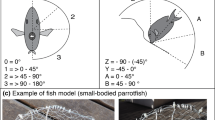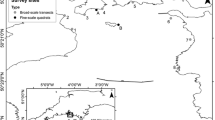Abstract
Understanding the mechanisms producing and maintaining discontinuities between patches in mosaics of habitats is necessary to predict changes in patterns of abundance and distribution of species. On temperate rocky reefs, physical and biological disturbance can result in a mosaic of patches of encrusting coralline, turf- or canopy-forming algae. We experimentally investigated the effects of disturbance within and at the boundary between these patches, in order to identify mechanisms accounting for re-colonisation of space and to assess whether the response of boundaries can alter the relative size of contrasting habitats. Also, we tested whether the resilience of the different types of assemblages depends on species richness (i.e. number of taxa present) of habitats or, alternatively, on other properties of systems like differences in life-history traits of dominating species. Although the nature of the mechanisms generating differences among habitats changed among different stages of the colonisation, local processes (within patches) prevailed over larger scale processes (among patches) in determining early patterns of colonisation of space in mosaics. By the end of the experiment, assemblages in clearings at boundaries had recovered to the undisturbed reference condition, in contrast to clearings within barren patches or algal turfs. Boundaries represent, therefore, relatively more stable components of the mosaic, with greater resilience than adjacent habitats. Although sea urchins are often indicated as the main force regulating the proportion of contrasting habitats on shallow rocky reefs, determining the nature of variation in the interaction between species dominating each type of habitat is crucial to understand dynamics of mosaics. Finally, our study provides evidence that resilience could not be entirely controlled by initial species diversity, suggesting that different proportions of dominant taxa could influence the stability of natural systems.



Similar content being viewed by others
References
Airoldi L (1998) Roles of disturbance, sediment stress, and substratum retention on spatial dominance in algal turf. Ecology 79:2759–2770
Airoldi L (2000) Responses of algae with different life histories to temporal and spatial variability of disturbance in subtidal reefs. Mar Ecol Prog Ser 195:81–92
Allison G (2004) The influence of species diversity and stress intensity on community resistance and resilience. Ecol Monogr 74:117–134
Anderson MJ (2001a) A new method for non-parametric multivariate analysis of variance. Aust Ecol 26:32–46
Anderson MJ (2001b) Permutation tests for univariate and multivariate analysis of variance and regression. Can J Fish Aquat Sci 58:626–639
Anderson MJ, Robinson J (2004) Generalized discriminant analysis based on distances. Aust N Z J Stat 45:301–318
Anderson MJ, Willis TJ (2003) Canonical analysis of principal coordinates: a useful method of constrained ordination for ecology. Ecology 84:511–525
Andrew NL (1993) Spatial heterogeneity, sea urchin grazing, and habitat structure on reefs in temperate Australia. Ecology 74:292–302
Bender EA, Case TJ, Gilpin ME (1984) Perturbation experiments in community ecology: theory and practice. Ecology 65:1–13
Benedetti-Cecchi L, Bulleri F, Cinelli F (1998) Density dependent foraging of sea urchins in shallow subtidal reefs on the west coast of Italy (Western Mediterranean). Mar Ecol Prog Ser 163:203–211
Bulleri F, Benedetti-Cecchi L, Cinelli F (1999) Grazing by the sea urchins Arbacia lixula L. and Paracentrotus lividus Lam. in the Northwest Mediterranean. J Exp Mar Biol Ecol 241:81–95
Bulleri F, Bertocci I, Micheli F (2002) Interplay of encrusting coralline algae and sea urchins in maintaining alternative habitats. Mar Ecol Prog Ser 243:101–109
Cadenasso ML, Pickett STA, Weathers KC, Bell SS, Benning TL, Carreiro MM, Dawson TE (2003a) An interdisciplinary and synthetic approach to ecological boundaries. Bioscience 53:717–722
Cadenasso ML, Pickett STA, Weathers KC, Jones CG (2003b) A framework for a theory of ecological boundaries. Bioscience 53:750–758
Clarke KR (1993) Non-parametric multivariate analysis of changes in community structure. Aust J Ecol 18:117–143
Connell JH, Keough MJ (1985) Disturbance and patch dynamics of subtidal marine animals on hard substrata. In: Pickett STA, White PS (eds) The ecology of natural disturbance and patch dynamics. Academic, London, pp 125–151
Dayton PK (1973) Dispersion, dispersal, and persistence of the annual intertidal alga Postelsia palmaeformis Ruprecht. Ecology 54:433–438
Denny MW (1987) Lift as a mechanism of patch initiation in mussel beds. J Exp Mar Biol Ecol 113:231–245
Dethier MN, Steneck RS (2001) Growth and persistence of diverse intertidal crusts: survival of the slow in a fast-paced world. Mar Ecol Prog Ser 223:89–100
Dethier MN, Graham ES, Cohen S, Tear LM (1993) Visual versus random-point percent cover estimations: ‘objective’ is not always better. Mar Ecol Prog Ser 110:9–18
Fagan WF, Cantrell RS, Cosner C (1999) How habitat edges change species interactions. Am Nat 153:165–182
Gagnon P, Himmelman JH, Johnson LE (2004) Temporal variation in community interfaces: kelp-bed boundary dynamics adjacent to persistent urchin barrens. Mar Biol 144:1191–1203
Ives AR, Klug JL, Gross K (2000) Stability and species richness in complex communities. Ecol Lett 3:399–411
Keough MJ (1984) Effects of patch size on the abundance of sessile marine invertebrates. Ecology 65:423–437
Konar B, Estes JA (2003) The stability of boundary regions between kelp beds and deforested areas. Ecology 84:174–185
Laurance WF, Didham RK, Power ME (2001) Ecological boundaries: a search for a synthesis. Trends Ecol Evol 16:70–71
McNaughton SJ (1983) Serengeti grassland ecology: the role of composite environmental factors and contingency in community organization. Ecol Monogr 53:291–320
Menge BA, Lubchenco J (1981) Community organization in temperate and tropical rocky intertidal habitats: prey refuges in relation to consumer pressure gradients. Ecol Monogr 51:429–450
Paine RT, Vadas RL (1969) The effects of grazing by sea urchins, Strongylocentrotus spp., on benthic algal populations. Limnol Oceanogr 14:710–719
Pearse JS, Hines AH (1979) Expansion of a central California kelp forest following the mass mortality of sea urchins. Mar Biol 51:83–91
Pfisterer AB, Schmid B (2002) Diversity-dependent production can decrease the stability of ecosystem functioning. Nature 416:84–86
Pickett STA, Cadenasso ML (1995) Landscape ecology: spatial heterogeneity in ecological systems. Science 269:331–334
Pickett STA, White PS (1985) Patch dynamics: a synthesis. In: Pickett STA, White PS (eds) The ecology of natural disturbance and patch dynamics. Academic, London, pp 371–384
Puyravaud JP, Pascal JP, Dufour C (1994) Ecotone structure as an indicator of changing forest savanna boundaries (Linganamakki region, Southern India). J Biogeogr 21:581–593
Reed DC, Laur DR, Ebeling AW (1988) Variation in algal dispersal and recruitment: the importance of episodic events. Ecol Monogr 58:321–335
Sankaran M, McNaughton SJ (1999) Determinants of biodiversity regulate compositional stability of communities. Nature 401:691–693
Santelices B (1990) Patterns of reproduction; dispersal and recruitment in seaweeds. Oceanogr Mar Biol Annu Rev 28:177–276
Scheffer M, Carpenter S, Foley JA, Folkes C, Walker B (2001) Catastrophic shifts in ecosystems. Nature 413:591–596
Scheibling RE (1986) Increased macroalgal abundance following mass mortalities of sea urchins (Strongylocentrotuts droebachiensis) along the Atlantic coast of Nova Scotia. Oecologia 68:186–198
Sousa WP (1984) Intertidal mosaics: patch size, propagule availability, and spatially variable patterns of succession. Ecology 65:1918–1935
Sousa WP (1985) Disturbance and patch dynamics on rocky intertidal shores. In: Pickett STA, White PS (eds) The ecology of natural disturbance and patch dynamics. Academic, London, pp 101–124
Steneck RS (1986) The ecology of coralline algal crusts: convergent patterns and adaptive strategies. Annu Rev Ecol Syst 17:273–303
Strayer DL, Power ME, Fagan WF, Pickett STA, Belnap J (2003) A classification of ecological boundaries. Bioscience 53:723–729
Underwood AJ (1997) Experiments in ecology: their logical design and interpretation using analysis of variance. Cambridge University Press, Cambridge
Valentine JP, Johnson CR (2005) Persistence of sea urchin (Heliocidaris erythrogramma) barrens on the east coast of Tasmania: inhibition of macroalgal recovery in the absence of high densities of sea urchins. Bot Mar 48:106–115
Yachi S, Loreau M (1999) Biodiversity and ecosystem productivity in a fluctuating environment: the insurance hypothesis. Proc Natl Acad Sci USA 96:1463–1468
Wardle DA, Bonner KI, Barker GM (2000) Stability of ecosystem properties in response to above-ground functional group richness and composition. Oikos 89:11–23
Wiens JA, Crawford CS, Gosz JR (1985) Boundary dynamics: a conceptual framework for studying landscape ecosystems. Oikos 45:412–427
Wilsey BJ, Potvin C (2000) Biodiversity and ecosystem functioning: importance of species evenness in an old field. Ecology 81:887–892
Winer BJ, Brown DR, Michels KM (1991) Statistical principles in experimental design. McGraw-Hill, New York
Acknowledgements
We thank I. Bertocci and F. Micheli for help in the field, L. Airoldi for thoughtful discussions on the topic and B. Konar for comments that helped to improve this manuscript. P. Petraitis, A. J. Underwood and one anonymous reviewer greatly improved the final version of this paper. We declare that our experiments comply with the current laws of Italy.
Author information
Authors and Affiliations
Corresponding author
Additional information
Communicated by Tony Underwood
Rights and permissions
About this article
Cite this article
Bulleri, F., Benedetti-Cecchi, L. Mechanisms of recovery and resilience of different components of mosaics of habitats on shallow rocky reefs. Oecologia 149, 482–492 (2006). https://doi.org/10.1007/s00442-006-0459-3
Received:
Accepted:
Published:
Issue Date:
DOI: https://doi.org/10.1007/s00442-006-0459-3




